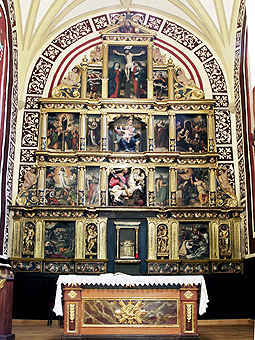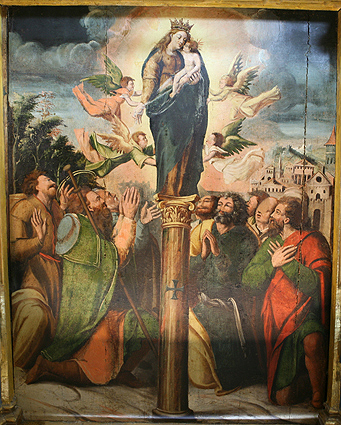The piece of the month of October 2007
A PAINTING OF THE VIRGIN OF THE PILLAR IN THE MAIN ALTARPIECE OF THE PARISH CHURCH OF SANTIAGO DE INTZA
María Josefa Tarifa Castilla
Chair de Patrimonio y Arte Navarro
The main altarpiece of the parish of Santiago de Intza, one of the six councils of the Araitz Valley, located in the foothills of the Malloak, is one of the significant works of Navarrese painting made within the framework of the third quarter of the 16th century, belonging to a painter from the Pamplona workshop. This movable property has recently been restored thanks to funding from the Institución Príncipe de Viana, which has made it possible refund to restore the altarpiece to part of its original splendor, blackened after having undergone several repaintings in the Baroque period, recovering the coloring of the Renaissance painting panels by cleaning them.

Main altarpiece of the parish church of Santiago de Intza
The altarpiece has among its panels a painting dedicated to the Virgin of Pilar. This iconography is interesting if we take into account that this Marian devotion is not very frequent in the 16th century, and even less so outside Aragon, since the moment in which the devotion is most developed is in the 17th century when numerous miraculous events are attributed to the Virgin of the Pilar, such as the famous miracle of Calanda (1640), being named patron saint of the city of Zaragoza on May 27, 1642 and since 1678 of the kingdom of Aragon.
The painting, which occupies the first panel on the left of the third body of the altarpiece, represents the Apparition of the Virgin of the Pillar to Santiago and the converts. The oldest known testimony of the account of the miracle of the coming of the Virgin of the Pilar to Zaragoza is preserved written in Latin at the end of a copy of the late thirteenth or early fourteenth century of the Moralia in Job of St. Gregory the Great, codex preserved in the Library Services chapter of La Seo de Zaragoza. This narration is the main and only canonical source to establish the iconography of this particular Marian invocation. The story establishes that the Virgin Mary, carried by angels from Jerusalem before her Assumption to heaven, appeared to James the Greater and eight of his converts during his stay in Zaragoza to spread the Gospel. The coming of the Virgin was at night on the banks of the Ebro River and while they were praying. Santiago and the converts heard the voices of two choirs of angels and in their midst they beheld the mother of God on a marble pillar. Mary ordered the apostle to build a church in that place and to place the pillar she had as a seat next to the altar. For this reason, the basilica that was built in her name was given the title of Santa Maria del Pilar. The Virgin concludes by prophesying the miracles that she will work in that place and its permanence and veneration until the end of the world. After the apparition, Santiago and the converts began the work of the chapel.

High altarpiece of the parish of Santiago de Intza.
Table of the Apparition of the Virgin of Pilar to Santiago and the converts.
In the panel of the altarpiece of the parish church of Intza, the upright Marian image with the child in her arms occupies the upper and central part of the scene, placed on a tall Corinthian capital column with a cross on its shaft and surrounded by four angels, two on each side, who float in the air with their wings spread, enveloping both the Virgin and the angelic creatures in a halo of orange light.
Mary is standing, in a slight contrapposto and slightly turned to the left, with a queenly crown framing a rounded face and delicate features, as befits a young woman, wearing her hair loose and curly on her shoulders covered by a yellow tunic and blue cloak that envelops her entire body. The painter made a fairly faithful reproduction of the Gothic image of Saint Mary (c. 1435-1438), patron saint of the basilica of Our Lady of Pilar, a wood carving that Mª Carmen Lacarra believes is the work of the sculptor Juan de la Huerta. But we must note that the image of Mary does not follow Gothic models, but rather sample a figure of a more slender canon and delicate forms, from agreement with Renaissance aesthetics.
The Virgin of the Navarre altarpiece holds in her left arm the naked body of her son, slightly tilted, maintaining an affectionate and maternal relationship between the two, as the Child turns towards his mother holding her neck with his right hand. Below her, around the shaft of the column, eight men are arranged, kneeling, prostrate on the ground, dressed in tunics, directing their gaze towards the Virgin, in very varied attitudes, some with their hands open, others with their hands joined in prayer and others with their hands crossed on their chests. Among these men we can identify Santiago Apostle, to the right of the Virgin, with the pilgrim's staff between his praying arms, his hat hanging on his back covered by a green cloak and a nimbus of sanctity on his head. In the background we can see some buildings, which in this case are supposed to recreate the city of Zaragoza, the place where the Virgin Mary carried by angels from Jerusalem before her Assumption to heaven appeared during the night to Santiago Apostle and to the converts with whom she was praying on the banks of the Ebro River. As in other panels of this altarpiece, there is a predominance in the polychrome of green, red and brown in the clothes of the characters that contrasts with the orange halo and the dark sky of the background.
One of the primitive woodcuts representing the Coming of Our Lady composes the frontispiece of the book Missa dedicationis apostolice ymo Angelice Basilice Beate Marie Maioris et de Pilari civitatis Cesarauguste regni Aragonum (1545-1547), in which perhaps our painter could have been inspired. In this work, of small dimensions, the Virgin holds the Child on her right side, and flanking her in the upper area are four angels carrying books and candlesticks, and in the lower area appear Santiago, the apostolic men and the royal family in a pious attitude.
bibliography
FERNÁNDEZ GRACIA, R. (COORD.), ECHEVERRÍA GOÑI, P.L. and GARCÍA GAINZA, M.C., El arte del Renacimiento en Navarra, Pamplona, Government of Navarra, 2005.
GARCÍA GAINZA, M.C., ORBE SIVATTE, M., DOMEÑO MARTÍNEZ DE MORENTIN, A. and AZANZA LÓPEZ, J.J., Catalog Monumental de Navarra, V*. Merindad de Pamplona, Pamplona, Institución Príncipe de Viana, 1994.
VVAA, El Pilar es la columna. Historia de una devoción, Zaragoza, Gobierno de Aragón-Ayuntamiento de Zaragoza, 1995.
ROY SINUSÍA, L., Huellas del Pilar. Colección de grabados del Cabildo Metropolitano de Zaragoza, Zaragoza, Cabildo Metropolitano, 1998.
